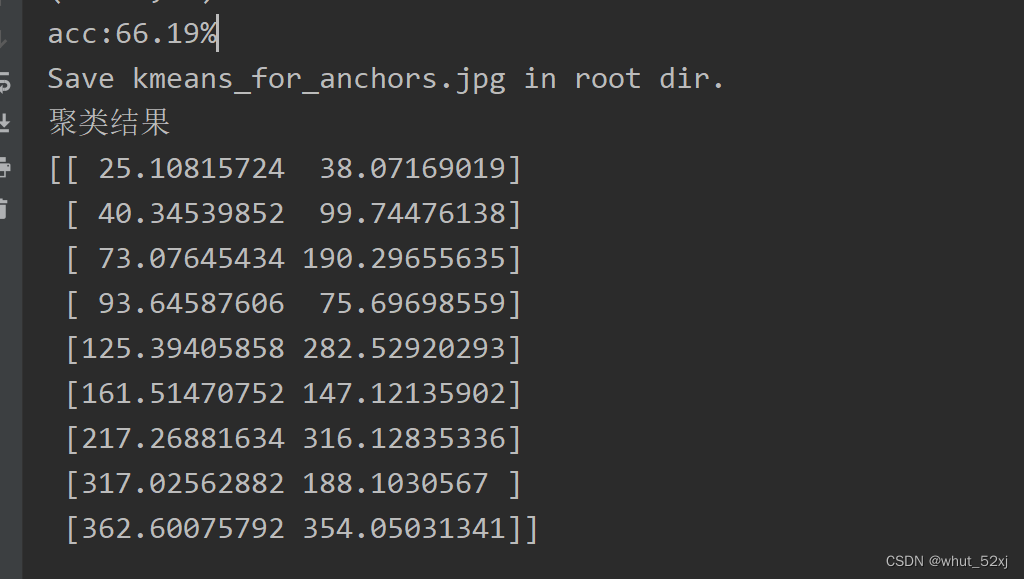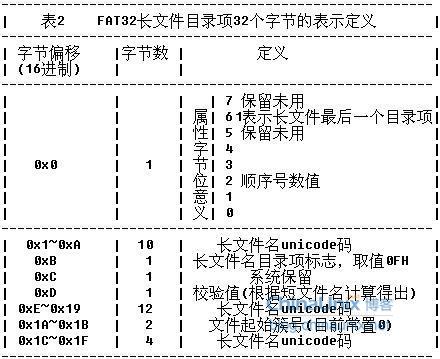kmeansanchors_0">kmeans++聚类生成anchors
说明
使用yolo系列通常需要通过kmeans聚类算法生成anchors,
但kmeans算法本身具有一定的局限性,聚类结果容易受初始值选取影响。
因此通过改进原kmeans_for_anchors.py实现 kmeans++聚类生成anchors。
具体实现如下:
python">import glob
import xml.etree.ElementTree as ET
from tqdm import tqdm
import numpy as np
def cas_iou(box, cluster):
x = np.minimum(cluster[:, 0], box[0])
y = np.minimum(cluster[:, 1], box[1])
intersection = x * y
area1 = box[0] * box[1]
area2 = cluster[:, 0] * cluster[:, 1]
iou = intersection / (area1 + area2 - intersection)
return iou
def avg_iou(box, cluster):
return np.mean([np.max(cas_iou(box[i], cluster)) for i in range(box.shape[0])])
def bboxesOverRation(bboxesA, bboxesB):
"""
功能等同于matlab的函数bboxesOverRation
bboxesA:M*4 array,形如[x,y,w,h]排布
bboxesB: N*4 array,形如[x,y,w,h]排布
"""
bboxesA = np.array(bboxesA.astype('float'))
bboxesB = np.array(bboxesB.astype('float'))
M = bboxesA.shape[0]
N = bboxesB.shape[0]
areasA = bboxesA[:, 2] * bboxesA[:, 3]
areasB = bboxesB[:, 2] * bboxesB[:, 3]
xA = bboxesA[:, 0] + bboxesA[:, 2]
yA = bboxesA[:, 1] + bboxesA[:, 3]
xyA = np.stack([xA, yA]).transpose()
xyxyA = np.concatenate((bboxesA[:, :2], xyA), axis=1)
xB = bboxesB[:, 0] + bboxesB[:, 2]
yB = bboxesB[:, 1] + bboxesB[:, 3]
xyB = np.stack([xB, yB]).transpose()
xyxyB = np.concatenate((bboxesB[:, :2], xyB), axis=1)
iouRatio = np.zeros((M, N))
for i in range(M):
for j in range(N):
x1 = max(xyxyA[i, 0], xyxyB[j, 0]);
x2 = min(xyxyA[i, 2], xyxyB[j, 2]);
y1 = max(xyxyA[i, 1], xyxyB[j, 1]);
y2 = min(xyxyA[i, 3], xyxyB[j, 3]);
Intersection = max(0, (x2 - x1)) * max(0, (y2 - y1));
Union = areasA[i] + areasB[j] - Intersection;
iouRatio[i, j] = Intersection / Union;
return iouRatio
def load_data(path):
data = []
# 对于每一个xml都寻找box
for xml_file in tqdm(glob.glob('{}/*xml'.format(path))):
tree = ET.parse(xml_file)
height = int(tree.findtext('./size/height'))
width = int(tree.findtext('./size/width'))
if height <= 0 or width <= 0:
continue
# 对于每一个目标都获得它的宽高
for obj in tree.iter('object'):
xmin = int(float(obj.findtext('bndbox/xmin'))) / width
ymin = int(float(obj.findtext('bndbox/ymin'))) / height
xmax = int(float(obj.findtext('bndbox/xmax'))) / width
ymax = int(float(obj.findtext('bndbox/ymax'))) / height
xmin = np.float64(xmin)
ymin = np.float64(ymin)
xmax = np.float64(xmax)
ymax = np.float64(ymax)
# 得到宽高
x = xmin + 0.5 * (xmax - xmin)
y = ymin + 0.5 * (ymax - ymin)
data.append([x, y, xmax - xmin, ymax - ymin])
return np.array(data)
def estimateAnchorBoxes(trainingData, numAnchors=9):
'''
功能:kmeans++算法估计anchor,类似于matlab函数estimateAnchorBoxes,当trainingData
数据量较大时候,自写的kmeans迭代循环效率较低,matlab的estimateAnchorBoxes得出
anchors较快,但meanIOU较低,然后乘以实际box的ratio即可。此算法由于优化是局部,易陷入局部最优解,结果不一致属正常
cuixingxing150@gmail.com
Example:
import scipy.io as scipo
data = scipo.loadmat(r'D:\Matlab_files\trainingData.mat')
trainingData = data['temp']
meanIoUList = []
for numAnchor in np.arange(1,16):
anchorBoxes,meanIoU = estimateAnchorBoxes(trainingData,numAnchors=numAnchor)
meanIoUList.append(meanIoU)
plt.plot(np.arange(1,16),meanIoUList,'ro-')
plt.ylabel("Mean IoU")
plt.xlabel("Number of Anchors")
plt.title("Number of Anchors vs. Mean IoU")
Parameters
----------
trainingData : numpy 类型
形如[x,y,w,h]排布,M*4大小二维矩阵
numAnchors : int, optional
估计的anchors数量. The default is 9.
Returns
-------
anchorBoxes : numpy类型
形如[w,h]排布,N*2大小矩阵.
meanIoU : scalar 标量
DESCRIPTION.
'''
numsObver = trainingData.shape[0]
xyArray = np.zeros((numsObver, 2))
trainingData[:, 0:2] = xyArray
assert (numsObver >= numAnchors)
# kmeans++
# init
centroids = [] # 初始化中心,kmeans++
centroid_index = np.random.choice(numsObver, 1)
centroids.append(trainingData[centroid_index])
while len(centroids) < numAnchors:
minDistList = []
for box in trainingData:
box = box.reshape((-1, 4))
minDist = 1
for centroid in centroids:
centroid = centroid.reshape((-1, 4))
ratio = (1 - bboxesOverRation(box, centroid)).item()
if ratio < minDist:
minDist = ratio
minDistList.append(minDist)
sumDist = np.sum(minDistList)
prob = minDistList / sumDist
idx = np.random.choice(numsObver, 1, replace=True, p=prob)
centroids.append(trainingData[idx])
# kmeans 迭代聚类
maxIterTimes = 100
iter_times = 0
while True:
minDistList = []
minDistList_ind = []
for box in trainingData:
box = box.reshape((-1, 4))
minDist = 1
box_belong = 0
for i, centroid in enumerate(centroids):
centroid = centroid.reshape((-1, 4))
ratio = (1 - bboxesOverRation(box, centroid)).item()
if ratio < minDist:
minDist = ratio
box_belong = i
minDistList.append(minDist)
minDistList_ind.append(box_belong)
centroids_avg = []
for _ in range(numAnchors):
centroids_avg.append([])
for i, anchor_id in enumerate(minDistList_ind):
centroids_avg[anchor_id].append(trainingData[i])
err = 0
for i in range(numAnchors):
if len(centroids_avg[i]):
temp = np.mean(centroids_avg[i], axis=0)
err += np.sqrt(np.sum(np.power(temp - centroids[i], 2)))
centroids[i] = np.mean(centroids_avg[i], axis=0)
iter_times += 1
if iter_times > maxIterTimes or err == 0:
break
anchorBoxes = np.array([x[2:] for x in centroids])
meanIoU = 1 - np.mean(minDistList)
print('acc:{:.2f}%'.format(avg_iou(trainingData[:, 2:], anchorBoxes) * 100))
return anchorBoxes, meanIoU
if __name__ == "__main__":
np.random.seed(0)
# 载入数据集,可以使用VOC的xml
path = 'VOCdevkit/VOC2007/Annotations'
# 生成的anchors的txt文件保存路径
anchorsPath = 'yolo_anchors++.txt'
# 生成的anchors数量
anchors_num = 9
# 输入的图片尺寸
input_shape = [416, 416]
print('Load xmls.')
data = load_data(path)
print('Load xmls done.')
# 使用k聚类算法
print('K-means++ boxes.')
anchors, _= estimateAnchorBoxes(data, numAnchors=anchors_num)
print('K-means boxes done.')
anchors = anchors * np.array([input_shape[1], input_shape[0]])
# 排序
cluster = anchors[np.argsort(anchors[:, 0])]
print("聚类结果")
print(cluster)
# 保存结果 生成yolo_anchors++.txt文件
f = open(anchorsPath, 'w')
row = np.shape(cluster)[0]
for i in range(row):
if i == 0:
x_y = "%d,%d" % (cluster[i][0], cluster[i][1])
else:
x_y = ", %d,%d" % (cluster[i][0], cluster[i][1])
f.write(x_y)
f.close()
使用voc数据集运行结果如下:
代码运行时间比较长,耐心等待即可!

参考
1.YOLOV4生成锚框kmeans_for_anchors.py
python">#-------------------------------------------------------------------------------------------------------#
# kmeans虽然会对数据集中的框进行聚类,但是很多数据集由于框的大小相近,聚类出来的9个框相差不大,
# 这样的框反而不利于模型的训练。因为不同的特征层适合不同大小的先验框,shape越小的特征层适合越大的先验框
# 原始网络的先验框已经按大中小比例分配好了,不进行聚类也会有非常好的效果。
#-------------------------------------------------------------------------------------------------------#
import glob
import xml.etree.ElementTree as ET
import matplotlib.pyplot as plt
import numpy as np
from tqdm import tqdm
def cas_iou(box, cluster):
x = np.minimum(cluster[:, 0], box[0])
y = np.minimum(cluster[:, 1], box[1])
intersection = x * y
area1 = box[0] * box[1]
area2 = cluster[:,0] * cluster[:,1]
iou = intersection / (area1 + area2 - intersection)
return iou
def avg_iou(box, cluster):
return np.mean([np.max(cas_iou(box[i], cluster)) for i in range(box.shape[0])])
def kmeans(box, k):
#-------------------------------------------------------------#
# 取出一共有多少框
#-------------------------------------------------------------#
row = box.shape[0]
#-------------------------------------------------------------#
# 每个框各个点的位置
#-------------------------------------------------------------#
distance = np.empty((row, k))
#-------------------------------------------------------------#
# 最后的聚类位置
#-------------------------------------------------------------#
last_clu = np.zeros((row, ))
np.random.seed()
#-------------------------------------------------------------#
# 随机选5个当聚类中心
#-------------------------------------------------------------#
cluster = box[np.random.choice(row, k, replace = False)]
iter = 0
while True:
#-------------------------------------------------------------#
# 计算当前框和先验框的宽高比例
#-------------------------------------------------------------#
for i in range(row):
distance[i] = 1 - cas_iou(box[i], cluster)
#-------------------------------------------------------------#
# 取出最小点
#-------------------------------------------------------------#
near = np.argmin(distance, axis=1)
if (last_clu == near).all():
break
#-------------------------------------------------------------#
# 求每一个类的中位点
#-------------------------------------------------------------#
for j in range(k):
cluster[j] = np.median(
box[near == j],axis=0)
last_clu = near
if iter % 5 == 0:
print('iter: {:d}. avg_iou:{:.2f}'.format(iter, avg_iou(box, cluster)))
iter += 1
return cluster, near
def load_data(path):
data = []
#-------------------------------------------------------------#
# 对于每一个xml都寻找box
#-------------------------------------------------------------#
for xml_file in tqdm(glob.glob('{}/*xml'.format(path))):
tree = ET.parse(xml_file)
height = int(tree.findtext('./size/height'))
width = int(tree.findtext('./size/width'))
if height<=0 or width<=0:
continue
#-------------------------------------------------------------#
# 对于每一个目标都获得它的宽高
#-------------------------------------------------------------#
for obj in tree.iter('object'):
xmin = int(float(obj.findtext('bndbox/xmin'))) / width
ymin = int(float(obj.findtext('bndbox/ymin'))) / height
xmax = int(float(obj.findtext('bndbox/xmax'))) / width
ymax = int(float(obj.findtext('bndbox/ymax'))) / height
xmin = np.float64(xmin)
ymin = np.float64(ymin)
xmax = np.float64(xmax)
ymax = np.float64(ymax)
# 得到宽高
data.append([xmax - xmin, ymax - ymin])
return np.array(data)
if __name__ == '__main__':
np.random.seed(0)
#-------------------------------------------------------------#
# 运行该程序会计算'./VOCdevkit/VOC2007/Annotations'的xml
# 会生成yolo_anchors.txt
#-------------------------------------------------------------#
input_shape = [416, 416]
anchors_num = 9
#-------------------------------------------------------------#
# 载入数据集,可以使用VOC的xml
#-------------------------------------------------------------#
path = 'C:\\Users\\52xj\\Desktop\\mobilenet-yolov4-pytorch-main\\mobilenet-yolov4-pytorch-main\\VOCdevkit\\VOC2007\\Annotations'
#-------------------------------------------------------------#
# 载入所有的xml
# 存储格式为转化为比例后的width,height
#-------------------------------------------------------------#
print('Load xmls.')
data = load_data(path)
print(data.shape)
data = data * np.array([input_shape[1], input_shape[0]])
print(data.shape)
print('Load xmls done.')
#-------------------------------------------------------------#
# 使用k聚类算法
#-------------------------------------------------------------#
print('K-means boxes.')
cluster, near = kmeans(data, anchors_num)
print('K-means boxes done.')
data = data * np.array([input_shape[1], input_shape[0]])
print(data.shape)
cluster = cluster * np.array([input_shape[1], input_shape[0]])
#-------------------------------------------------------------#
# 绘图
#-------------------------------------------------------------#
for j in range(anchors_num):
plt.scatter(data[near == j][:,0], data[near == j][:,1])
plt.scatter(cluster[j][0], cluster[j][1], marker='x', c='black')
plt.savefig("kmeans_for_anchors.jpg")
plt.show()
print('Save kmeans_for_anchors.jpg in root dir.')
cluster = cluster[np.argsort(cluster[:, 0] * cluster[:, 1])]
print('avg_ratio:{:.2f}'.format(avg_iou(data, cluster)))
print(cluster)
f = open("yolo_anchors.txt", 'w')
row = np.shape(cluster)[0]
for i in range(row):
if i == 0:
x_y = "%d,%d" % (cluster[i][0], cluster[i][1])
else:
x_y = ", %d,%d" % (cluster[i][0], cluster[i][1])
f.write(x_y)
f.close()
2.Kmeans++聚类算法
重新思考Anchor Box估计

代码实现
python">def bboxesOverRation(bboxesA,bboxesB):
"""
功能等同于matlab的函数bboxesOverRation
bboxesA:M*4 array,形如[x,y,w,h]排布
bboxesB: N*4 array,形如[x,y,w,h]排布
"""
bboxesA = np.array(bboxesA.astype('float'))
bboxesB = np.array(bboxesB.astype('float'))
M = bboxesA.shape[0]
N = bboxesB.shape[0]
areasA = bboxesA[:,2]*bboxesA[:,3]
areasB = bboxesB[:,2]*bboxesB[:,3]
xA = bboxesA[:,0]+bboxesA[:,2]
yA = bboxesA[:,1]+bboxesA[:,3]
xyA = np.stack([xA,yA]).transpose()
xyxyA = np.concatenate((bboxesA[:,:2],xyA),axis=1)
xB = bboxesB[:,0] +bboxesB[:,2]
yB = bboxesB[:,1]+bboxesB[:,3]
xyB = np.stack([xB,yB]).transpose()
xyxyB = np.concatenate((bboxesB[:,:2],xyB),axis=1)
iouRatio = np.zeros((M,N))
for i in range(M):
for j in range(N):
x1 = max(xyxyA[i,0],xyxyB[j,0]);
x2 = min(xyxyA[i,2],xyxyB[j,2]);
y1 = max(xyxyA[i,1],xyxyB[j,1]);
y2 = min(xyxyA[i,3],xyxyB[j,3]);
Intersection = max(0,(x2-x1))*max(0,(y2-y1));
Union = areasA[i]+areasB[j]-Intersection;
iouRatio[i,j] = Intersection/Union;
return iouRatio
def estimateAnchorBoxes(trainingData,numAnchors=9):
'''
功能:kmeans++算法估计anchor,类似于matlab函数estimateAnchorBoxes,当trainingData
数据量较大时候,自写的kmeans迭代循环效率较低,matlab的estimateAnchorBoxes得出
anchors较快,但meanIOU较低,然后乘以实际box的ratio即可。此算法由于优化是局部,易陷入局部最优解,结果不一致属正常
cuixingxing150@gmail.com
Example:
import scipy.io as scipo
data = scipo.loadmat(r'D:\Matlab_files\trainingData.mat')
trainingData = data['temp']
meanIoUList = []
for numAnchor in np.arange(1,16):
anchorBoxes,meanIoU = estimateAnchorBoxes(trainingData,numAnchors=numAnchor)
meanIoUList.append(meanIoU)
plt.plot(np.arange(1,16),meanIoUList,'ro-')
plt.ylabel("Mean IoU")
plt.xlabel("Number of Anchors")
plt.title("Number of Anchors vs. Mean IoU")
Parameters
----------
trainingData : numpy 类型
形如[x,y,w,h]排布,M*4大小二维矩阵
numAnchors : int, optional
估计的anchors数量. The default is 9.
Returns
-------
anchorBoxes : numpy类型
形如[w,h]排布,N*2大小矩阵.
meanIoU : scalar 标量
DESCRIPTION.
'''
numsObver = trainingData.shape[0]
xyArray = np.zeros((numsObver,2))
trainingData[:,0:2] = xyArray
assert(numsObver>=numAnchors)
# kmeans++
# init
centroids = [] # 初始化中心,kmeans++
centroid_index = np.random.choice(numsObver, 1)
centroids.append(trainingData[centroid_index])
while len(centroids)<numAnchors:
minDistList = []
for box in trainingData:
box = box.reshape((-1,4))
minDist = 1
for centroid in centroids:
centroid = centroid.reshape((-1,4))
ratio = (1-bboxesOverRation(box,centroid)).item()
if ratio<minDist:
minDist = ratio
minDistList.append(minDist)
sumDist = np.sum(minDistList)
prob = minDistList/sumDist
idx = np.random.choice(numsObver,1,replace=True,p=prob)
centroids.append(trainingData[idx])
# kmeans 迭代聚类
maxIterTimes = 100
iter_times = 0
while True:
minDistList = []
minDistList_ind = []
for box in trainingData:
box = box.reshape((-1,4))
minDist = 1
box_belong = 0
for i,centroid in enumerate(centroids):
centroid = centroid.reshape((-1,4))
ratio = (1-bboxesOverRation(box,centroid)).item()
if ratio<minDist:
minDist = ratio
box_belong = i
minDistList.append(minDist)
minDistList_ind.append(box_belong)
centroids_avg = []
for _ in range(numAnchors):
centroids_avg.append([])
for i,anchor_id in enumerate(minDistList_ind):
centroids_avg[anchor_id].append(trainingData[i])
err = 0
for i in range(numAnchors):
if len(centroids_avg[i]):
temp = np.mean(centroids_avg[i],axis=0)
err += np.sqrt(np.sum(np.power(temp-centroids[i],2)))
centroids[i] = np.mean(centroids_avg[i],axis=0)
iter_times+=1
if iter_times>maxIterTimes or err==0:
break
anchorBoxes = np.array([x[2:] for x in centroids])
meanIoU = 1-np.mean(minDistList)
return anchorBoxes,meanIoU




